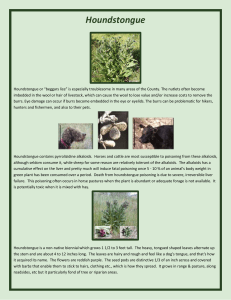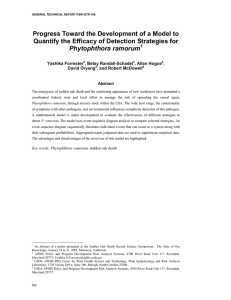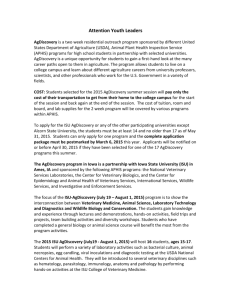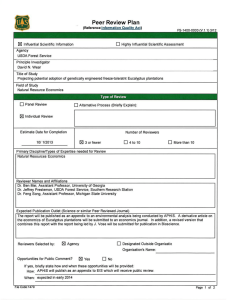Pest Alert Mogulones Cruciger
advertisement
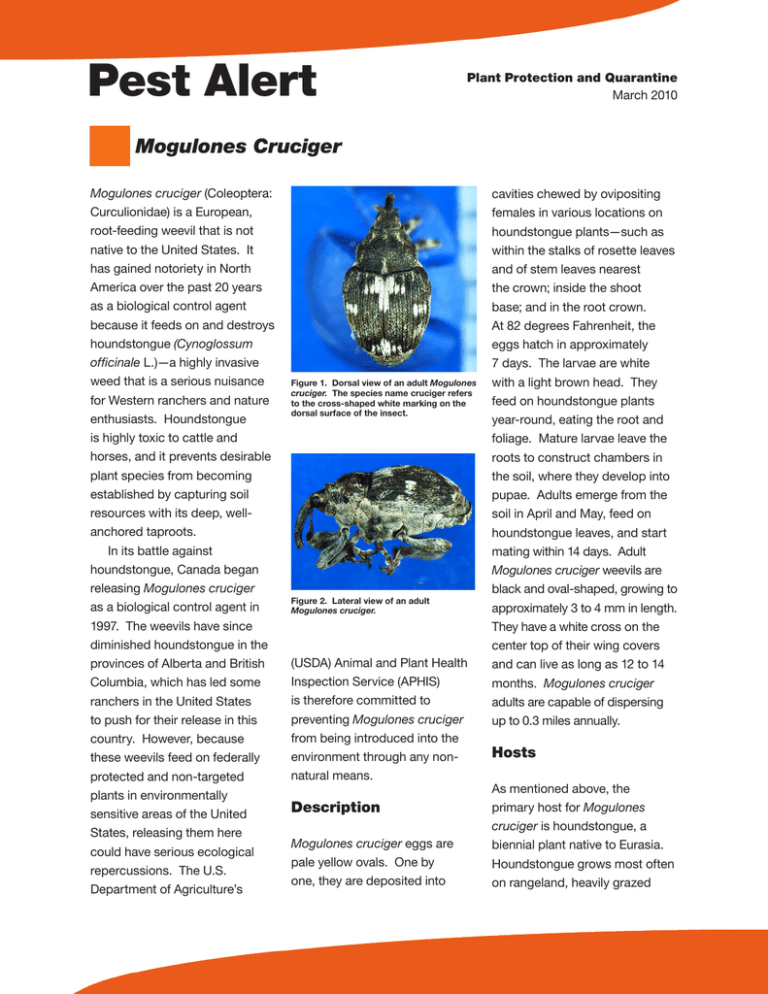
Pest Alert Plant Protection and Quarantine March 2010 Mogulones Cruciger Mogulones cruciger (Coleoptera: Curculionidae) is a European, root-feeding weevil that is not native to the United States. It has gained notoriety in North America over the past 20 years as a biological control agent because it feeds on and destroys houndstongue (Cynoglossum officinale L.)—a highly invasive weed that is a serious nuisance for Western ranchers and nature enthusiasts. Houndstongue is highly toxic to cattle and horses, and it prevents desirable plant species from becoming established by capturing soil resources with its deep, wellanchored taproots. In its battle against houndstongue, Canada began releasing Mogulones cruciger as a biological control agent in 1997. The weevils have since diminished houndstongue in the provinces of Alberta and British Columbia, which has led some ranchers in the United States to push for their release in this country. However, because these weevils feed on federally protected and non-targeted plants in environmentally sensitive areas of the United States, releasing them here could have serious ecological repercussions. The U.S. Department of Agriculture’s cavities chewed by ovipositing females in various locations on houndstongue plants—such as within the stalks of rosette leaves and of stem leaves nearest the crown; inside the shoot base; and in the root crown. At 82 degrees Fahrenheit, the eggs hatch in approximately Figure 1. Dorsal view of an adult Mogulones cruciger. The species name cruciger refers to the cross-shaped white marking on the dorsal surface of the insect. Figure 2. Lateral view of an adult Mogulones cruciger. (USDA) Animal and Plant Health Inspection Service (APHIS) is therefore committed to preventing Mogulones cruciger from being introduced into the environment through any nonnatural means. Description Mogulones cruciger eggs are pale yellow ovals. One by one, they are deposited into 7 days. The larvae are white with a light brown head. They feed on houndstongue plants year-round, eating the root and foliage. Mature larvae leave the roots to construct chambers in the soil, where they develop into pupae. Adults emerge from the soil in April and May, feed on houndstongue leaves, and start mating within 14 days. Adult Mogulones cruciger weevils are black and oval-shaped, growing to approximately 3 to 4 mm in length. They have a white cross on the center top of their wing covers and can live as long as 12 to 14 months. Mogulones cruciger adults are capable of dispersing up to 0.3 miles annually. Hosts As mentioned above, the primary host for Mogulones cruciger is houndstongue, a biennial plant native to Eurasia. Houndstongue grows most often on rangeland, heavily grazed pastures, logged woodland, and other natural areas that have been disturbed. Its seeds stick to clothing and animals, which enables the plant to spread long distances. Since its accidental introduction into the United States and Canada more than a century ago, houndstongue is now established in 45 States and every Canadian province. While this exotic weed is difficult to control, it is a problem primarily States from releases made in Canada in the late 1990s, APHIS remains committed to preventing this pest from entering the United States by human-assisted means. APHIS will not issue permits for the field release or interstate movement of Mogulones cruciger within the United States. APHIS only allows the weevils to be imported into a U.S. quarantine facility. Although the insect appears A State-by-State listing of these contacts is available on the APHIS Web site at www.aphis. usda.gov/services/report_pest_ disease/report_pest_disease. shtml. in dry areas of the Northwestern United States and western Canada. Houndstongue is a member of the Boraginaceae family of shrubs, trees, and herbs, most of which are distinguished by hairy leaves. A number of common plants belong to this family, including forget-menot, heliotrope, and comfrey. There are 2,000 species in the Boraginaceae plant family—many of which are listed as threatened or endangered. Mogulones cruciger weevils feed on a broad range of these plants. to provide some level of control for houndstongue, this benefit does not outweigh the potential negative environmental impacts it could have on endangered plant species. Unauthorized collection, transportation, and release of Mogulones cruciger as a biological control agent against houndstongue in the United States is a criminal violation of the Endangered Species Act, with penalties for punishable offenses ranging from a maximum fine of up to $50,000 or imprisonment for 1 year, or both, and civil penalties of up to $25,000 per violation. These actions are also a violation of the Plant Protection Act, with fines of up to $250,000 per count for noncompliance, or up to $1 million per adjudication if the violation is willful. number is (866) 524-5421, the local number is (301) 7340841, and the e-mail address is Pest.Permits@aphis.usda.gov. Contact information is also listed online at www.aphis.usda.gov/ contact_us/ppq.shtml. Potential Impact Research indicates that releasing the Mogulones cruciger weevil in the United States will pose risks to native Boraginaceae species—including rare and endangered species, as well as the areas or habitats that are critical to those species’ survival. Although Mogulones cruciger spread naturally into the United How You Can Help To report a possible Mogulones cruciger finding, please contact your State plant health director. Additional Information For additional information, please contact APHIS Plant Protection and Quarantine’s permit services office. The toll-free telephone USDA is an equal opportunity provider and employer. Photo credits: All photos were taken by APHIS entomologist Patrick Marquez. United States Department of Agriculture Animal and Plant Health Inspection Service APHIS 81–35–014 Issued March 2010
